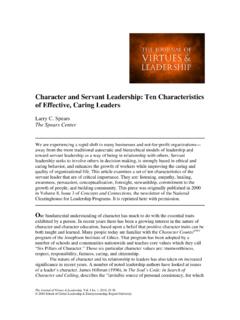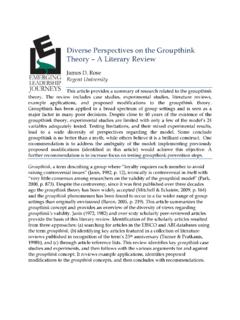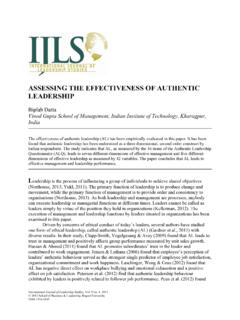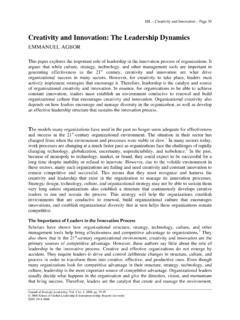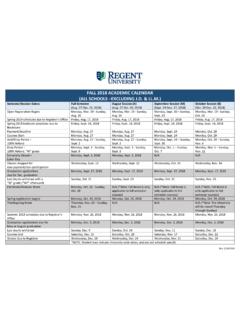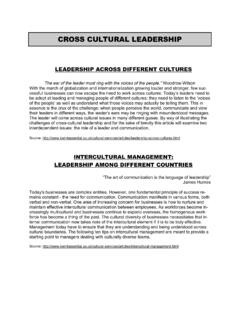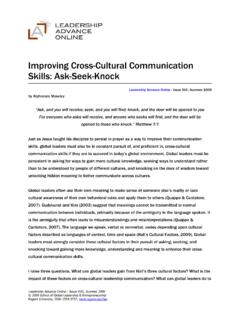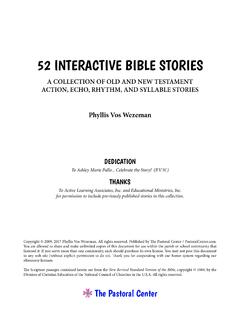Transcription of Mahatma Gandhi - An Indian Model of Servant Leadership
1 International Journal of Leadership Studies, Vol. 7 Iss. 2, 2012 2012 School of Global Leadership &Entrepreneurship, Regent University ISSN 1554-3145 Mahatma Gandhi AN Indian Model OF Servant Leadership Annette Barnabas College of Engineering, Tiruchirappalli, India Paul Sundararajan Clifford B. School, Triruchirappalli, India This study explores the Leadership qualities of Mahatma Gandhi in relation to six behavioral dimensions of the Servant Leadership Behaviour Scale (SLBS) Model of Servant Leadership , proposed by Sendjaya, Sarros and Santora (2008), and highlights the importance of Servant Leadership qualities like service, self- sacrificial love, spirituality, integrity, simplicity, emphasizing follower needs, and modelling.
2 It is a literary investigation of the life and Leadership qualities of Gandhi , based on various books, personal correspondence, and statements including the autobiography of Mahatma Gandhi The Story of My Experiments with the Truth by using the Model of SLBS. This research study demonstrates that Mahatma Gandhi personified the Servant Leadership Behaviour Scale Model and illustrates the Indian contribution to Servant Leadership . It elucidates the need to include the concept of Servant Leadership in the curriculum of business schools and advocates the practice of Servant Leadership in different Leadership positions. eadership is an important area of study and research in business schools for decades now.
3 There have been numerous research findings too in the Western countries on Leadership (Jain & Mukherji, 2009, p. 435). But there is a scarcity of research on indigenous models of Leadership in India, even though there are many excellent business schools in India along with skilled human talent (Jain & Mukherji, 2009, p. 435). Shahin and Wright (2004) argue that it is necessary to exercise caution when attempting to apply Western Leadership theories in non-Western countries, because all concepts may not be relevant for effective Leadership in these countries. India is a fascinating and diverse country with many languages, cultures, castes, and religions.
4 India has been shaped by various great leaders like Mahatma Gandhi , Rabindranath Tagore, Jawaharlal Nehru, Sarojini Naidu, and Ambedkar. These leaders are role models for Leadership , and their outstanding Leadership qualities can be studied and practiced in these days of worldwide change and development, because of the impact that they made in India by their Leadership . An important method of Leadership development is by vicarious learning, which is based on learning from role models (Popper, 2005). There is a scarcity of research in India on the type L Barnabas & Paul/ INTERNATIONAL JOURNAL OF Leadership STUDIES 133 International Journal of Leadership Studies, Vol.
5 7 Iss. 2, 2012 2012 School of Global Leadership &Entrepreneurship, Regent University ISSN 1554-3145 of Leadership that can be taught and practiced in Leadership development programs and Business Schools based on these indigenous role models (Jain & Mukherji, 2009, p. 435). This study aims to study the Servant Leadership qualities of Mahatma Gandhi , the great role Model of truth and non-violence in Indian history (Nair, 1994, p. 7), and the great freedom fighter and Servant leader from India, so that this concept can be taught and practiced by Indian and worldwide leaders. Gandhi is widely acknowledged as one of the greatest leaders of the non-violent movements the world has ever seen.
6 As a pioneer of Satyagraha (Shridharani, 1939), which is resistance through non-violent civil disobedience, he became one of the major political leaders of his time. Many other great leaders, like Martin Luther King Jr. (McGuire & Hutchings, 2007, p. 154) and Nelson Mandela (Fawell, 2007, p. 228), were inspired by the philosophy of non-violence of Gandhi . Many writers have acknowledged that Gandhi was a Servant leader (Sims, 1994; Koshal, 2005; Blanchard & Miller, 2007; Nordquist, 2008; Salleh, 2009). Albert Einstein (1939, p. 80) referred to Gandhi as a beacon to the generations to come. The purpose of this paper is to re-examine the outstanding qualities of Servant Leadership that Gandhi provided and deconstruct the constituent components of his Leadership to arrive at a better understanding of the qualities, characteristics, and effectiveness of Servant Leadership .
7 Ford and Lawler (2007) find that the dominance of the behavioral and attitudinal dimensions in quantitative empirical studies of Leadership has resulted in a relative dearth of qualitative approaches. There is hardly any study to find out whether Gandhi possessed all the characteristics of a Servant leader. For this purpose, the Servant Leadership Behaviour Scale (SLBS) Model of Servant Leadership with six dimensions proposed by Sendjaya, Sarros, and Santora (2008) is used in this study to examine the Servant Leadership qualities of Gandhi . This SLBS scale was developed as a result of extensive review of literature and it reflects a more comprehensive construct of Servant Leadership compared with existing measures.
8 The paper begins with a brief definition of Servant Leadership and the Indian origin of Leadership concept. This is followed by an examination of the Model of Servant Leadership and the investigation of the extent to which Mahatma Gandhi exemplified these qualities, as indicated by reference to excerpts from his personal life and work. The paper concludes with a discussion of how the Servant Leadership characteristics initiated by Gandhi can be studied and practised in India and all over the world. Introduction to Servant Leadership Robert K. Greenleaf coined the modern term Servant - Leadership (Spears, 1996) in 1970 in the essay entitled, The Servant as Leader, after reading Herman Hesse s (1956) short novel, Journey to the East.
9 After reading this story, Greenleaf concluded that the central meaning of this novel was that a great leader must first of all become a Servant and get the experience as a Servant , and that this is central to his or her greatness (Spears, 1996). There are many passages in the Bible which depict the Servant Leadership qualities of Jesus christ of Nazareth, who lived in the first century and taught His disciples, But he who is greatest among you shall be your Servant (Matt. 23:11; New King James Version of the Holy Bible). Jesus modelled His teaching on Servant Leadership by washing the feet of His disciples, including the one who was to betray Him.
10 Barnabas & Paul/ INTERNATIONAL JOURNAL OF Leadership STUDIES 134 International Journal of Leadership Studies, Vol. 7 Iss. 2, 2012 2012 School of Global Leadership &Entrepreneurship, Regent University ISSN 1554-3145 Indian Origin of Servant Leadership Concept The Mahabharata, written by Rishi Veda Vyasa, is one of the two major Sanskrit epics of ancient India, the other being the R m yana (Hee, 2007). The Bhagavad Gita is part of the Mahabharata and is one of the most revered Hindu manuscripts. Rarick and Nickerson (2009) state that a leader as per Gita tradition is a humanistic leader, a person who acts without self-gain, and who has great personal concern for followers.

